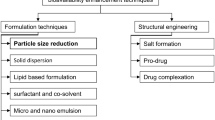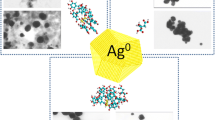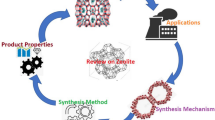Abstract
Purpose
The effects of milling and particle size on surface energies of form I paracetamol crystals are reported.
Methods
Paracetamol crystals (75–850 μm) were obtained by cooling methanol and acetone saturated solutions. Additionally, macroscopic (>2 cm) single crystals were grown by slow solvent evaporation from saturated solutions, ball milled and sieved into different particle size fractions. Surface properties were characterised using Inverse Gas Chromatography and compared with those calculated from sessile drop contact angle measurements on macroscopic single crystals.
Results
Dispersive surface energies, \( \gamma ^{d}_{{{\text{SV}}}} \) for milled samples increased by 20% with decreasing particle size. With decreasing particle size acceptor numbers, K A values were constant but donor numbers, K B decreased. For unmilled materials K B was comparable to K A but with a significantly lower \( \gamma ^{d}_{{{\text{SV}}}} \)of only 33 mJ/m2. Milling resulted in fracture along the crystal's lowest attachment energy plane (010), exposing facets of different surface chemistry to that of the native external facets. θ for the (010) fracture plane confirmed a higher \( \gamma ^{d}_{{{\text{SV}}}} \) compared to external facets such as (011) of single crystals.
Conclusions
Milling exposes a hydrophobic surface for paracetamol form I crystals which becomes increasingly more dominant with decreasing particle size.





Similar content being viewed by others
References
R. C. Rowe. Correlation between predicted binder spreading coefficients and measured granule and tablet properties in the granulation of paracetamol. Int. J. Pharm. 58:209–213 (1990).
G. Buckton. Assessment of the wettability of pharmaceutical powders. In: K. L. Mittal (ed.), Contact Angle, Wettability and Adhesion, VSP, Utrecht, The Netherlands, 1993, pp. 437–451.
D. Winn and M. F. Doherty. Modeling crystal shapes of organic materials grown from solution. AIChE J. 46:1348–1367 (2000).
V. Chikhalia, R. T. Forbes, R. A. Storey, and M. Ticehurst. The effect of crystal morphology and mill type on milling induced crystal disorder. Eur. J. Pharm. Sci. 27:19–26 (2006).
T. Young. An essay on the cohesion of fluids. Philos. Trans. R. Soc. Lon. 95:65–87 (1805).
D. Williams. Inverse gas chromatography. In: H. Ishida (ed.), Characterisation of Composite Materials, Butterworth-Heinemann, London, 1994, pp. 80–104.
F. Thielmann. Introduction into the characterisation of porous materials by inverse gas chromatography. J. Chromatogr. A 1037:115–123 (2004).
J. R. Conder and C. L. Young. Physicochemical Measurement by Gas Chromatography. Wiley, Chichester, 1979.
A. V. Kiselev and Y. I. Yashin. Gas-Adsorption Chromatography. Plenum, London, 1969.
E. Papirer and H. Balard. In: E. Pefferkorn (ed.), Interfacial Phenomena in Chromatography, Marcel Dekker, New York, 1999.
H. E. Newell, G. Buckton, D. A. Butler, F. Thielmann, and D. R. Williams. The use of inverse phase gas chromatography to study the change of surface energy of amorphous lactose as a function of relative humidity and the processes of collapse and crystallisation. Int. J. Pharm. 217:45–56 (2001).
H. E. Newell, G. Buckton, D. A. Butler, F. Thielmann, and D. R. Williams. The use of inverse gas chromatography to measure the surface energy of crystalline, amorphous and recently milled lactose. Pharm. Res. 18:662–666 (2001).
I. M. Grimsey, J. C. Feeley, and P. York. Analysis of the surface energy of pharmaceutical powders by inverse gas chromatography. J. Pharm. Sci. 91:571–583 (2002).
I. M. Grimsey, J. C. Osborn, S. W. Doughty, P. York, and R. C. Rowe. The application of molecular modelling to the interpretation of inverse gas chromatography data. J. Chromatogr. A 969:49–57 (2002).
M. D. Ticehurst, R. C. Rowe, and P. York. Determination of the surface properties of two batches of salbutamol sulphate by inverse gas chromatography. Int. J. Pharm. 111:241–249 (1994).
P. York, M. D. Ticehurst, J. C. Osborn, R. J. Roberts, and R. C. Rowe. Characterisation of the surface energetics of milled dl-propranolol hydrochloride using inverse gas chromatography and molecular modelling. Int. J. Pharm. 174:179–186 (1998).
J. Y. Y. Heng, D. F. Pearse, D. A. Wilson, and D. R. Williams. Characterization of solid state materials using vapor sorption methods. In: A. Zakrzewski and M. Zakrzewski (eds.), Solid State Characterization of Pharmaceuticals, ASSA, Danbury Connecticut, 2006.
G. Buckton. Characterisation of small changes in the physical properties of powders of significance for dry powder inhaler formulations. Adv. Drug Deliv. Rev. 26:17–27 (1997).
F. M. Fowkes. Attractive forces at interfaces. Ind. Eng. Chem. 56:40–52 (1964).
J. Schultz, L. Lavielle, and C. Martin. The role of the interface in carbon fibre-spoxy composites. J. Adhes. 23:45–60 (1987).
G. M. Dorris and D. G. Gray. Adsorption of n-alkanes at zero surface coverage on cellulose paper and wood fibers. J. Colloid Interface Sci. 77:353–362 (1980).
U. Panzer and H. P. Schreiber. On the evaluation of surface interactions by inverse gas chromatography. Macromolecules 25:3631–3633 (1992).
V. Gutmann. Coordination chemistry of certain transition-metal ions. The role of solvent. Coord. Chem. Rev. 2:239–256 (1966).
F. L. Riddle and F. M. Fowkes. Spectral shifts in acid-base chemistry. 1. van der Waals contribution to acceptor numbers. J. Am. Chem. Soc. 112:3259–3264 (1990).
J. W. Mullin. Crystallization, 3rd ed. Butterworth-Heinemann, Oxford, 1993.
J. Y. Y. Heng, A. Bismarck, A. F. Lee, K. Wilson, and D. R. Williams. Anisotropic wettability of macroscopic form I paracetamol crystals. Langmuir 22:2760–2769 (2006).
E. M. Ålander, M. S. Uusi-Penttila, and Å. C. Rasmuson. Agglomeration of paracetamol during crystallization in pure and mixed solvents. Ind. Eng. Chem. Res. 43:629–637 (2004).
R. I. Ristic, S. Finnie, D. B. Sheen, and J. N. Sherwood. Macro- and micromorphology of monoclinic paracetamol grown from pure aqueous solution. J. Phys. Chem. B 105:9057–9066 (2001).
W. C. Duncan-Hewitt, D. L. Mount, and A. Yu. Hardness anisotropy of acetaminophen crystals. Pharm. Res. 11:616–623 (1994).
G. Nichols and C. S. Frampton. Physicochemical characterization of the orthorhombic polymorph of paracetamol crystallized from solution. J. Pharm. Sci. 87:684–693 (1998).
I. M. Grimsey, J. C. Feeley, and P. York. Analysis of the surface energy of pharmaceutical powders by inverse gas chromatography. J. Pharm. Sci. 91:571–583 (2002).
M. Ohta and G. Buckton. Determination of the changes in surface energetics of cefditoren pivoxil as a consequence of processing induced disorder and equilibration to different relative humidities. Int. J. Pharm. 269:81–88 (2004).
L. Trowbridge, I. M. Grimsey, and P. York. Influence of milling on the surface properties of acetaminophen. AAPS PharmSci (Suppl.)(1):310 (1998).
Author information
Authors and Affiliations
Corresponding author
Rights and permissions
About this article
Cite this article
Heng, J.Y.Y., Thielmann, F. & Williams, D.R. The Effects of Milling on the Surface Properties of Form I Paracetamol Crystals. Pharm Res 23, 1918–1927 (2006). https://doi.org/10.1007/s11095-006-9042-1
Received:
Accepted:
Published:
Issue Date:
DOI: https://doi.org/10.1007/s11095-006-9042-1




